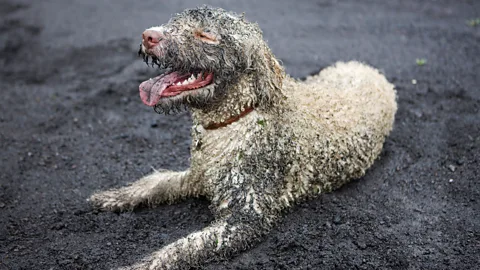How your pets alter your immune system
 Getty Images
Getty ImagesLiving with animals is thought to have profound effects on our immunity – potentially reducing the risk of allergies, eczema and even autoimmune conditions.
Since they first emigrated from Central Europe to North America in the 18th Century, the Amish have become known for their unique lifestyle. Today they are reliant on the same practices of dairy cattle farming and horse-borne transportation that were followed by their ancestors for centuries.
The Amish have gripped the imaginations of Hollywood scriptwriters, documentary makers and sociologists for decades. But in the past 10 years, their way of life has become of increasing interest to the medical world too, as they seem to defy one particularly concerning modern trend. While rates of immune-related conditions which begin in childhood, such as asthma, eczema and allergies, have soared since the 1960s, this has not been the case for the Amish.
The reason for this is revealing insights into how our immune systems operate – and the profound ways that the animals in our lives are affecting them.
A diverse community
To try and understand why the Amish have lower rates of certain immune conditions, a group of scientists spent time back in 2012 with an Amish community in the state of Indiana, and with another farming community known as the Hutterites, in South Dakota. In both cases, they took blood samples from 30 children and studied their immune systems in detail.
There are many similarities between the two groups. Like the Amish, the Hutterites also live off the land, have European ancestry, have minimal exposure to air pollution and follow a diet which is low in processed foods. However, their rates of asthma and childhood allergies are between four and six times higher than among the Amish.
One difference between the two communities is that while the Hutterites have fully embraced industrialised farming technologies, the Amish have not, meaning that from a young age, they live in close with animals and the plethora of microbes that they carry.
"If you look at an aerial drone photographs of Amish settlements, and compare them with Hutterite communities, the Amish are living on the farm with the animals, whereas the Hutterites live in little hamlets, and the farm could be a few miles away," says Fergus Shanahan, professor emeritus of medicine at University College Cork, Ireland.
In 2016, a team of scientists from the US and published a now-landmark study concluding that Amish children have a lower risk of allergies because of the way their environments shape their immune systems. In particular, the researchers found that the Amish children in their study had more finely tuned so-called regulatory T cells than those from Hutterite backgrounds. These cells help to dampen down unusual immune responses.
 Getty Images
Getty ImagesWhen the researchers scanned dust samples collected from the homes of Amish and Hutterite children for signs of bacteria, they found clear evidence that Amish children were being exposed to more microbes, likely from the animals that they lived among.
Around the world, other scientists have been making similar findings. A group of immunologists reported that children growing up on Alpine farms, where cows typically sleep in close proximity to their owners, seemed to be protected against asthma, hayfever and eczema. Other research has found that a child's allergy risk at ages seven to nine seems to decrease proportionally with the number of pets which were present in the home in their early years of life, dubbed the "mini-farm effect".
"It's not a universal cure-all, and every time I give a lecture on this, someone goes, 'Well I grew up on a farm and I've got allergies', but we know that if you grow up physically interacting with farm animals, you have about a 50% reduction in your likelihood of developing asthma or allergies," says Jack Gilbert, a professor at the University of California San Diego who was involved in the Amish study, and also cofounded the American Gut Project – a citizen science project studying how our lifestyles affect our microbiomes. "Even if you just grow up with a dog in your home, you have a 13-14% reduction in risk," he says.
A new study published in January 2025 found that having a dog at home could help to prevent eczema in some children who are genetically prone to the condition. In an analysis of almost 280,000 people, researchers found that for those with a known risk factor for eczema – a particular variant of a gene involved in immune cell function and inflammation known as interleiukin-7 receptor (IL-7R) – they were less likely to develop the condition if they had lived with a family dog in their first two years of life.
Laboratory tests confirmed that molecular signals from dogs can suppress skin inflammation. However, the researchers warned that introducing a dog may not help with existing eczema and could even make symptoms worse.
Protective pets
Since the Amish study was first published, the potentially protective effect of interacting with animals during childhood has been the subject of much fascination, with the New York Times even publishing an article asking whether pets are the new "probiotic".
So what's going on? Perhaps unsurprisingly, given the tactile nature of humans and our fondness for stroking and fondling our pets, when we live with animals, microbes from their fur and paws have been shown to end up on our skin – at least temporarily.
This has led to suggestions that the "microbiome" could be colonised by bugs from our pets. This is the collection of vast colonies of microbes that live on our skin, in our mouths and most notably in the gut, which hosts a significant concentration of our body's immune cells. According to Nasia Safdar, an infectious disease professor at the University of Wisconsin in the US, this concept has attracted interest from the pet food industry. The idea would be to develop products marketed as promoting the growth of beneficial bacteria in cats and dogs, which might then be transferred to their owners, she says.
"That angle has been an attractive one for people to fund, because for most of us, it's the human condition that we're interested in," says Safdar. "So what role can the animal play in that">window._taboola = window._taboola || []; _taboola.push({ mode: 'alternating-thumbnails-a', container: 'taboola-below-article', placement: 'Below Article', target_type: 'mix' });
